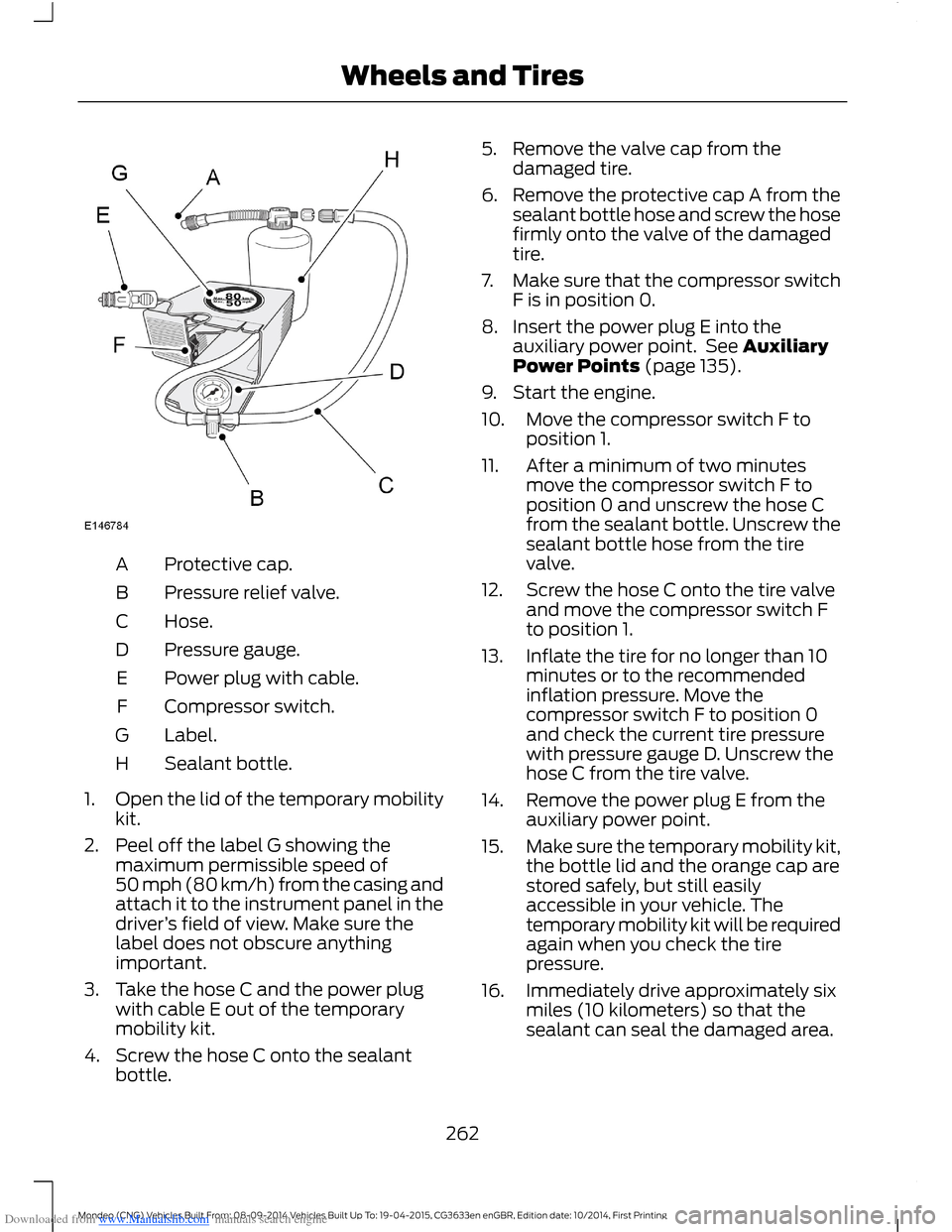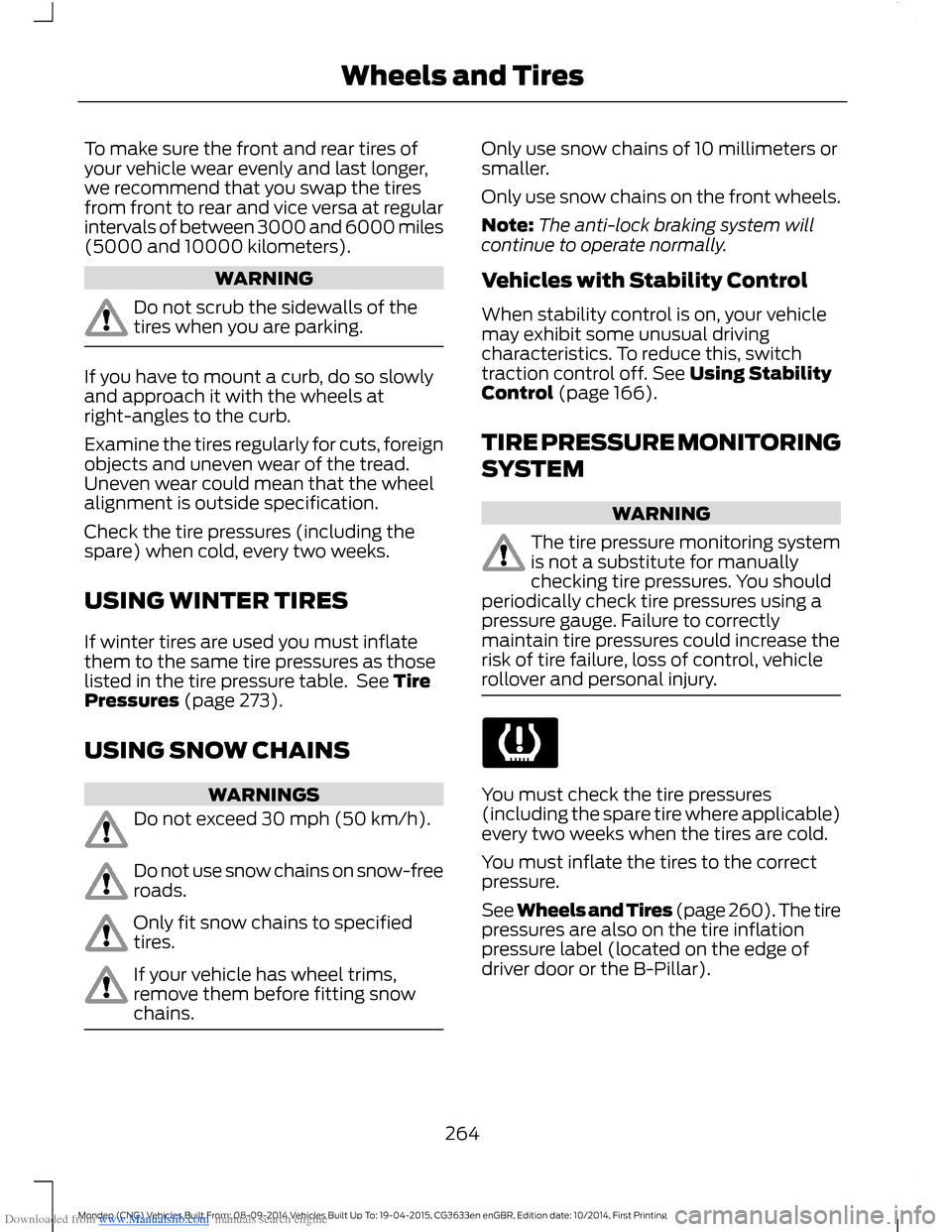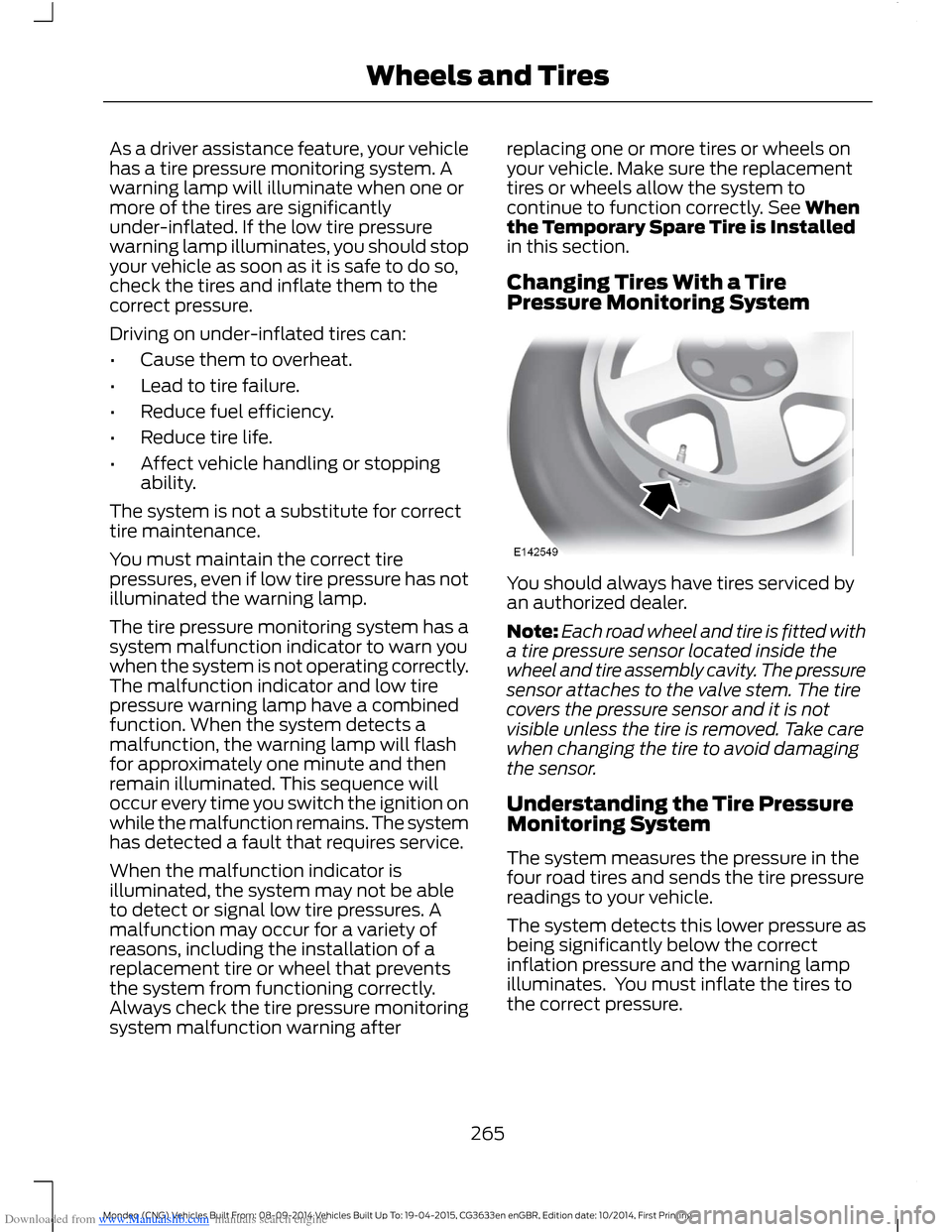2014 FORD MONDEO inflation pressure
[x] Cancel search: inflation pressurePage 32 of 446

Downloaded from www.Manualslib.com manuals search engine The airbag will deploy during significantlateral collisions. It will also deploy duringsignificant frontal angled collisions. Thecurtain airbag will not deploy in minorlateral and frontal collisions, rear collisions,or overturns.
INFLATABLE SAFETY BELTS
Rear Inflatable Safety Belt (If
Equipped)
WARNINGS
Do not attempt to service, repair, ormodify the rear inflatable safety belt.
If the rear inflatable safety belt hasdeployed, it will not function again.The rear inflatable safety belt systemmust be replaced by an authorized dealer.
The rear inflatable safety belts are fittedin the shoulder portion of the safety beltsof the second-row outboard seatingpositions.
Note:The rear inflatable safety belts areonly compatible with belt positioningbooster seats of Group 2 and 3 whenproperly installed. See Installing ChildSeats (page 17). This is because they aredesigned to fill with a cooled gas at a lowerpressure and at a slower rate thantraditional airbags. After inflation, theshoulder portion of the safety belt remainscool to the touch.
The rear inflatable safety belt consists ofthe following:
•An inflatable bag located in theshoulder safety belt webbing.
•Lap safety belt webbing withautomatic locking mode.
•The same warning light, electroniccontrol and diagnostic unit as used forthe front safety belts.
•Impact sensors located in various partsof the vehicle.
How does the rear inflatable safety beltsystem work?
The rear inflatable safety belts willfunction like standard restraints ineveryday usage.
During a crash of sufficient force, theinflatable belt will inflate from inside thewebbing.
30Mondeo (CNG) Vehicles Built From: 08-09-2014 Vehicles Built Up To: 19-04-2015, CG3633en enGBR, Edition date: 10/2014, First PrintingSupplementary Restraints System
Page 263 of 446

Downloaded from www.Manualslib.com manuals search engine WARNINGS
You must only use the temporarymobility kit for the vehicle with whichit was supplied.
Before you use the temporary mobility kit:
•Apply the parking brake.
•Do not attempt to remove foreignmaterial that is penetrating the tire, forexample, nails or screws.
•Leave the engine running while thetemporary mobility kit is in use. If yourvehicle is in an enclosed or poorlyventilated area use the temporarymobility kit with the engine switchedoff.
•You must replace the sealant bottlewith a new one before the expiry datewhich is printed on the top of sealantbottle.
•Inform all vehicle users that a tire hasbeen repaired using the temporarymobility kit. Make them aware of thespecial driving conditions that apply.
Inflating the Tire
WARNINGS
Check the sidewall of the tire prior tousing the temporary mobility kit. Ifthere are any cracks, bumps orsimilar damage do not attempt to inflatethe tire.
Do not stand directly beside the tirewhile the compressor is operating.
Watch the sidewall of the tire. If anycracks, bumps or similar damageappears, switch off the compressorimmediately and deflate the tire using thepressure relief valve B.
WARNINGS
The sealant contains natural rubberlatex. Avoid contact with skin orclothing. If this happens, rinse theaffected areas immediately with plenty ofwater and contact a physician.
If the tire inflation pressure does notreach the recommended pressurewithin 10 minutes, the tire may havesuffered excessive damage, making atemporary repair impossible. Do notcontinue driving with this tire.
Screwing the sealant bottle onto thebottle holder will pierce the seal ofthe sealant bottle. Do not unscrewthe sealant bottle from the bottle holderprior to completing a temporary repair asthe sealant will escape.
If you experience heavy vibrations,unsteady steering behavior or noiseswhile driving, reduce your speed anddrive with caution to a place where it issafe for you to stop your vehicle. Recheckthe tire and its pressure. If the tire pressureis less than 45 psi (3 bar) or if there are anycracks, bumps or similar damage visible,do not continue driving with this tire.
261Mondeo (CNG) Vehicles Built From: 08-09-2014 Vehicles Built Up To: 19-04-2015, CG3633en enGBR, Edition date: 10/2014, First PrintingWheels and Tires
Page 264 of 446

Downloaded from www.Manualslib.com manuals search engine Protective cap.A
Pressure relief valve.B
Hose.C
Pressure gauge.D
Power plug with cable.E
Compressor switch.F
Label.G
Sealant bottle.H
1.Open the lid of the temporary mobilitykit.
2.Peel off the label G showing themaximum permissible speed of50 mph (80 km/h) from the casing andattach it to the instrument panel in thedriver’s field of view. Make sure thelabel does not obscure anythingimportant.
3.Take the hose C and the power plugwith cable E out of the temporarymobility kit.
4.Screw the hose C onto the sealantbottle.
5.Remove the valve cap from thedamaged tire.
6.Remove the protective cap A from thesealant bottle hose and screw the hosefirmly onto the valve of the damagedtire.
7.Make sure that the compressor switchF is in position 0.
8.Insert the power plug E into theauxiliary power point. See AuxiliaryPower Points (page 135).
9.Start the engine.
10.Move the compressor switch F toposition 1.
11.After a minimum of two minutesmove the compressor switch F toposition 0 and unscrew the hose Cfrom the sealant bottle. Unscrew thesealant bottle hose from the tirevalve.
12.Screw the hose C onto the tire valveand move the compressor switch Fto position 1.
13.Inflate the tire for no longer than 10minutes or to the recommendedinflation pressure. Move thecompressor switch F to position 0and check the current tire pressurewith pressure gauge D. Unscrew thehose C from the tire valve.
14.Remove the power plug E from theauxiliary power point.
15.Make sure the temporary mobility kit,the bottle lid and the orange cap arestored safely, but still easilyaccessible in your vehicle. Thetemporary mobility kit will be requiredagain when you check the tirepressure.
16.Immediately drive approximately sixmiles (10 kilometers) so that thesealant can seal the damaged area.
262Mondeo (CNG) Vehicles Built From: 08-09-2014 Vehicles Built Up To: 19-04-2015, CG3633en enGBR, Edition date: 10/2014, First PrintingWheels and Tires
Page 265 of 446

Downloaded from www.Manualslib.com manuals search engine Note:When pumping in the sealant throughthe tire valve, the pressure may rise up to87 psi (6 bar) but will drop again after about30 seconds.
WARNING
If you experience heavy vibrations,unsteady steering behavior or noiseswhile driving, reduce your speed anddrive with caution to a place where it issafe for you to stop your vehicle. Recheckthe tire and its pressure. If the tire pressureis less than the recommended pressure orif there are any cracks, bumps or similardamage visible, do not continue drivingwith this tire.
Checking the Tire Pressure
WARNING
Before driving make sure the tire isadjusted to the recommendedinflation pressure. See TirePressures (page 273). Monitor the tirepressure until the sealed tire is replaced.
1.Stop your vehicle after driving aboutsix miles (10 kilometers). Check, andwhere necessary, adjust the pressureof the damaged tire.
2.Attach the temporary mobility kit andcheck the tire pressure from thepressure gauge D.
3.If the pressure of the sealant-filled tireis more than the recommendedpressure, adjust it to the recommendedpressure. See Tire Pressures (page273).
4.Follow the inflation procedure onceagain to inflate the tire.
5.Check the tire pressure again from thepressure gauge D. If the tire pressure istoo high, deflate the tire to thespecified pressure using the pressurerelief valve B.
6.If the tire pressure is less than therecommended pressure, repeat steps13 to 16 and steps 1 to 5 (Checking theTire Pressure).
7.Once you have inflated the tire to itscorrect tire pressure, move thecompressor switch F to position 0,remove the power plug E from theauxiliary power point, unscrew thesealant bottle hose, fasten the valvecap and replace the protective cap A.
8.Drive to the nearest tire specialist toget the damaged tire replaced. Beforethe tire is removed from the wheel,inform the tire specialist that the tirecontains sealant. Renew the sealantbottle as soon as possible after it hasbeen used once.
Note:The temporary mobility kit onlyprovides an emergency repair. Regulationsconcerning tire repair after using thetemporary mobility kit may differ fromcountry to country. You should consult a tirespecialist for advice.
Empty sealant bottles can be disposed oftogether with normal household waste.Return remaining sealant to an authorizeddealer or dispose of it in compliance withlocal waste disposal regulations.
TIRE CARE
263Mondeo (CNG) Vehicles Built From: 08-09-2014 Vehicles Built Up To: 19-04-2015, CG3633en enGBR, Edition date: 10/2014, First PrintingWheels and Tires
Page 266 of 446

Downloaded from www.Manualslib.com manuals search engine To make sure the front and rear tires ofyour vehicle wear evenly and last longer,we recommend that you swap the tiresfrom front to rear and vice versa at regularintervals of between 3000 and 6000 miles(5000 and 10000 kilometers).
WARNING
Do not scrub the sidewalls of thetires when you are parking.
If you have to mount a curb, do so slowlyand approach it with the wheels atright-angles to the curb.
Examine the tires regularly for cuts, foreignobjects and uneven wear of the tread.Uneven wear could mean that the wheelalignment is outside specification.
Check the tire pressures (including thespare) when cold, every two weeks.
USING WINTER TIRES
If winter tires are used you must inflatethem to the same tire pressures as thoselisted in the tire pressure table. See TirePressures (page 273).
USING SNOW CHAINS
WARNINGS
Do not exceed 30 mph (50 km/h).
Do not use snow chains on snow-freeroads.
Only fit snow chains to specifiedtires.
If your vehicle has wheel trims,remove them before fitting snowchains.
Only use snow chains of 10 millimeters orsmaller.
Only use snow chains on the front wheels.
Note:The anti-lock braking system willcontinue to operate normally.
Vehicles with Stability Control
When stability control is on, your vehiclemay exhibit some unusual drivingcharacteristics. To reduce this, switchtraction control off. See Using StabilityControl (page 166).
TIRE PRESSURE MONITORING
SYSTEM
WARNING
The tire pressure monitoring systemis not a substitute for manuallychecking tire pressures. You shouldperiodically check tire pressures using apressure gauge. Failure to correctlymaintain tire pressures could increase therisk of tire failure, loss of control, vehiclerollover and personal injury.
You must check the tire pressures(including the spare tire where applicable)every two weeks when the tires are cold.
You must inflate the tires to the correctpressure.
See Wheels and Tires (page 260).The tirepressures are also on the tire inflationpressure label (located on the edge ofdriver door or the B-Pillar).
264Mondeo (CNG) Vehicles Built From: 08-09-2014 Vehicles Built Up To: 19-04-2015, CG3633en enGBR, Edition date: 10/2014, First PrintingWheels and Tires
Page 267 of 446

Downloaded from www.Manualslib.com manuals search engine As a driver assistance feature, your vehiclehas a tire pressure monitoring system. Awarning lamp will illuminate when one ormore of the tires are significantlyunder-inflated. If the low tire pressurewarning lamp illuminates, you should stopyour vehicle as soon as it is safe to do so,check the tires and inflate them to thecorrect pressure.
Driving on under-inflated tires can:
•Cause them to overheat.
•Lead to tire failure.
•Reduce fuel efficiency.
•Reduce tire life.
•Affect vehicle handling or stoppingability.
The system is not a substitute for correcttire maintenance.
You must maintain the correct tirepressures, even if low tire pressure has notilluminated the warning lamp.
The tire pressure monitoring system has asystem malfunction indicator to warn youwhen the system is not operating correctly.The malfunction indicator and low tirepressure warning lamp have a combinedfunction. When the system detects amalfunction, the warning lamp will flashfor approximately one minute and thenremain illuminated. This sequence willoccur every time you switch the ignition onwhile the malfunction remains. The systemhas detected a fault that requires service.
When the malfunction indicator isilluminated, the system may not be ableto detect or signal low tire pressures. Amalfunction may occur for a variety ofreasons, including the installation of areplacement tire or wheel that preventsthe system from functioning correctly.Always check the tire pressure monitoringsystem malfunction warning after
replacing one or more tires or wheels onyour vehicle. Make sure the replacementtires or wheels allow the system tocontinue to function correctly. See Whenthe Temporary Spare Tire is Installedin this section.
Changing Tires With a TirePressure Monitoring System
You should always have tires serviced byan authorized dealer.
Note:Each road wheel and tire is fitted witha tire pressure sensor located inside thewheel and tire assembly cavity. The pressuresensor attaches to the valve stem. The tirecovers the pressure sensor and it is notvisible unless the tire is removed. Take carewhen changing the tire to avoid damagingthe sensor.
Understanding the Tire PressureMonitoring System
The system measures the pressure in thefour road tires and sends the tire pressurereadings to your vehicle.
The system detects this lower pressure asbeing significantly below the correctinflation pressure and the warning lampilluminates. You must inflate the tires tothe correct pressure.
265Mondeo (CNG) Vehicles Built From: 08-09-2014 Vehicles Built Up To: 19-04-2015, CG3633en enGBR, Edition date: 10/2014, First PrintingWheels and Tires
Page 268 of 446

Downloaded from www.Manualslib.com manuals search engine When the Temporary Spare Tire isInstalled
If you need to replace a road wheel andtire with the temporary spare wheel, thesystem will continue to identify a defect.This is to remind you to repair the damagedroad wheel and tire and refit the repairedroad wheel and tire assembly to yourvehicle. To restore the correct operationof the system, you must have the repaired
road wheel and tire assembly refitted toyour vehicle.
When You Believe the System is NotOperating Correctly
The main function of the system is to warnyou when the tire pressures are low. It canalso warn you in the event the system isno longer capable of operating correctly.See the following chart for informationconcerning the system:
ActionDescriptionWarning lamp
1.Make sure tires are at the correctpressure. See Wheels and Tires(page 260). The tire pressures are alsoon the tire inflation pressure label(located on the edge of driver dooror the B-Pillar).
2.After inflating the tires to the correctpressure you must carry out the tirepressure monitoring system resetprocedure. See Tire PressureMonitoring System ResetProcedure in this chapter.
Tire(s) under-inflatedSolid warning lamp
Repair the damaged road wheel and tireand refit the repaired road wheel and tireassembly to your vehicle to restore thecorrect operation of the system.
Spare tire in use
If the tires are correctly inflated and thespare tire is not in use but the lightremains on, the system has detected afault that requires service.
Tire pressure monitoringsystem malfunction
Repair the damaged road wheel and tireand refit the repaired road wheel and tireassembly to your vehicle to restore thecorrect operation of the system.
Spare tire in useSolid warning lampinitially followed bya flashing warninglamp
If the tires are correctly inflated and thespare tire is not in use but the lightremains on, the system has detected afault that requires service.
Tire pressure monitoringsystem malfunction
266Mondeo (CNG) Vehicles Built From: 08-09-2014 Vehicles Built Up To: 19-04-2015, CG3633en enGBR, Edition date: 10/2014, First PrintingWheels and Tires
Page 269 of 446

Downloaded from www.Manualslib.com manuals search engine Tire Pressure Monitoring SystemReset Procedure
Overview
You must carry out the system resetprocedure after each tire replacement oradjustment of the tire pressures.
To maintain your vehicle load carryingcapability, your vehicle requires differenttire pressures in the front tires comparedto the rear tires.
The system illuminates the warning lampat different pressures for the front and reartires.
The tires need to be periodically rotatedto provide consistent performance andmaximum tire life, the system needs toknow when the tires have been rotated todetermine which set of tires are on thefront and rear axles. With this information,the system can detect and correctly warnof low tire pressures.
Carrying Out the System ResetProcedure
Switch the ignition on. Using theinformation display control select:
Description and ActionMessage
Press the OK button.Settings
Press the OK button.Driver assist
Press and hold the OK button until confirmation appears.Alternatively, if your vehicle has a tire pressure monitoringsystem reset button, press and hold the button untilconfirmation appears.
Tire Monitor
How Temperature Affects the TirePressures
Under normal driving conditions tirepressures may increase by up to 4 psi(0.3 bar) from a cold start situation.
If the vehicle is stationary overnight andthe temperature significantly lower thanthe daytime temperature, tire pressuresmay decrease by up to 3 psi (0.2 bar) whenthere is a drop in the ambient temperatureof 63°F (17°C) or more. The systemdetects this pressure decrease as beingsignificantly below the correct inflationpressure and the warning lamp illuminates.
When Inflating the Tires
When inflating the tires the system maynot respond immediately to the air addedto the tires.
If the Warning Lamp is On:
1.Check each tire to verify that none areflat.
2.If one or more tires are flat, repair asnecessary.
3.Check the tire pressures and inflate allthe tires to the correct pressure.
4.Carry out the tire pressure monitoringsystem reset procedure.
267Mondeo (CNG) Vehicles Built From: 08-09-2014 Vehicles Built Up To: 19-04-2015, CG3633en enGBR, Edition date: 10/2014, First PrintingWheels and Tires